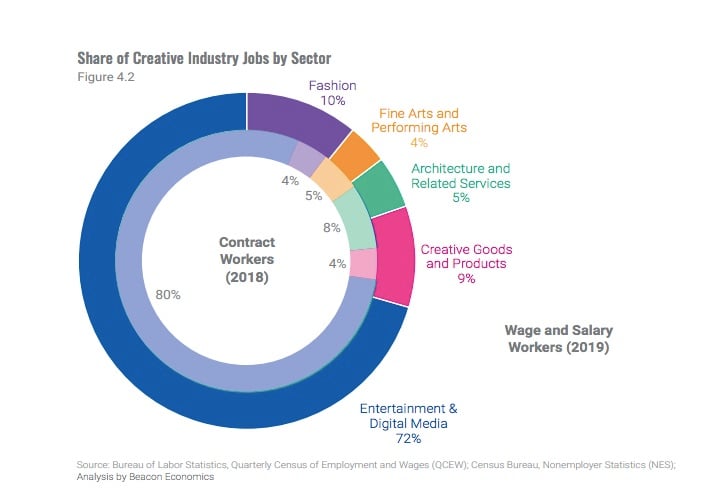Analysis
Steep Job Losses in California, Home to the Largest Creative Economy in the US, Spell Trouble for the Rest of the Country, a Report Says
The report's authors hope to suggest a path to recovery.

The report's authors hope to suggest a path to recovery.

Eileen Kinsella

A study released today by the prestigious Otis College of Art and Design in Los Angeles paints a clear and unflattering portrait of the damage the pandemic has wrought on the California art world and its related industries.
According to the paper, which is the school’s 15th annual edition, the creative economy lost more than 13 percent of its job in California, and more than 25 percent in Los Angeles County. The motion picture and video production sector endured the brunt of the impact, with nearly 92,000 jobs lost nationwide; California accounted for roughly 60,000 of those, while Los Angeles County alone accounted for about 50,000.
The five creative sectors analyzed in the report all incurred significant job losses: the entertainment and digital media industry lost 128,100 jobs; the fashion sector shed 22,870 workers; 15,900 fine and performing arts jobs disappeared; the creative goods and products field lost 5,800; and the architecture and related services industry lost 2,700.
The total creative-sector job losses statewide in California are estimated at 175,360. And since California represents the biggest creative economy in the US, the results can be seen as a barometer of broader nationwide trends.
“Last year was the most unusual year in the history of the report and, because of that, the 2021 Otis College Report might be the most important one yet,” the school’s president, Charles Hirschhorn, writes in the introduction.
The publication presents “stories of how the COVID-19 pandemic has disrupted some and buoyed others,” Hirschhorn writes. “As policymakers look for ways to revive the economy, we hope the Otis College Report will provide an important resource.”

Image courtesy Otis College of Art and Design, Los Angeles.a
The Otis report also includes data analysis of the Paycheck Protection Program (PPP) program and the annual business survey from the US Census, among other statistics.
“These datasets help build an empirical understanding around minority-owned creative businesses in California and the demographics of self-employed workers in the creative economy,” according to the report. “They also allow for more robust reporting on high-level, non-profit organization and employment counts across California.”
The findings will be presented today during a virtual event with opening remarks by US Representative Karen Bass of California’s 37th district. Adam Fowler, director of research at Beacon Economics, and Julie Baker, executive director of Californians for the Arts/California Arts Advocates, will also present.
Californias for the Arts is simultaneously releasing the results of two COVID-19 economic impact surveys to provide more context about the pandemic’s impact on the arts.
Of the nearly 1,000 creative workers surveyed in those studies, 83 percent said the pandemic had impacted their employment, and 88 percent said they had lost income. Of those who identified as educators, 90 percent lost income due to the coronavirus.
According to a companion study of more than 600 California creative businesses, 79 percent said they had eliminated or reduced programs and 16 percent said they were not sure whether they would survive if programs could not resume before April 1. The surveys also found that a large number of creative workers are considering relocating from California in the absence of additional economic aid.
Otis began issuing its annual reports in 2007, focusing at first only on Los Angeles County. In 2013, it expanded its scope to eight regions in the state, from Northern California to San Diego.